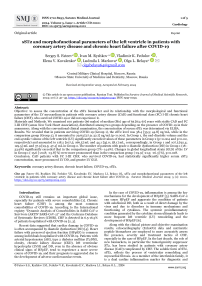sST2 and morphofunctional parameters of the left ventricle in patients with coronary artery disease and chronic heart failure after COVID-19
Автор: Sergey S. Fateev, Ivan M. Ryzhkov, Vladimir K. Fedulov, Elena V. Kovalenko, Ludmila I. Markova, Olga L. Belaya
Журнал: Saratov Medical Journal @sarmj
Статья в выпуске: 1 Vol.5, 2024 года.
Бесплатный доступ
Objective: to assess the concentration of the sST2 biomarker and its relationship with the morphological and functional parameters of the LV myocardium in patients with coronary artery disease (CAD) and functional class (FC) I-III chronic heart failure (CHF), who survived COVID-19 or did not experience it. Materials and Methods. We examined 100 patients (66 males) of median (Me) age of 65 [63; 67] years with stable CAD and FC I-III CHF (sensu New York Heart Association), distributed among two groups depending on the presence of COVID-19 in their anamneses. Along with the conventional clinical examination, the concentration of serum sST2 was determined via ELISA. Results. We revealed that in patients surviving COVID-19 (Group 1), the sST2 level was 38.4 [35.5; 44.8] ng/mL, while in the comparison group (Group 2), it amounted to 29.63 [27.9; 32.7] ng/mL (p<0.001). In Group 1, the end-diastolic volume and the end-systolic volume of the left ventricle (LV) significantly exceeded values of these parameters in Group 2 (p=0.004 and p=0.02, respectively) and amounted to 118.2 [107.5; 166.5] mL and 44.1 [35.0; 58.1] mL, correspondingly, in Group 1 and 107.5 [92.4; 129.5] mL and 37.9 [29.5; 47.4] mL in Group 2. The number of patients with grade 2 diastolic dysfunction (DD) in Group 1 (18–33.9%) significantly exceeded that in the comparison group (7%–14.9%). Changes in global longitudinal strain (GLS) of the LV in Group 1 (-15.6 [-20.8; -13.8] %) were more pronounced than in the comparison group (-19.9 [-21.5; -16.3] %), p=0.018. Conclusion. CAD patients with FC I-III CHF, who survived COVID-19, had statistically significantly higher serum sST2 concentration, more pronounced LV DD, and greater LV GLS.
Coronary artery disease, chronic heart failure, COVID-19, sST2
Короткий адрес: https://sciup.org/149147105
IDR: 149147105 | DOI: 10.15275/sarmj.2024.0101
Список литературы sST2 and morphofunctional parameters of the left ventricle in patients with coronary artery disease and chronic heart failure after COVID-19
- Ferrara P, Albano L. COVID-19 and healthcare systems: What should we do next? Public Health. 2020; (185): 1-2. https://www.doi.org/10.1016/j.puhe.2020.05.014
- Arutyunov GP, Tarlovskaya EI, Arutyunov AG, et al. International registry “Dynamic Analysis of Comorbidities in SARS-CoV-2 Survivors (AKTIV SARS-CoV-2)”: Analysis of 1,000 patients. Russ J Cardiol. 2020; 25 (11): 4165. (In Russ.). https://www.doi.org/10.15829/1560-4071-2020-4165
- Pierpaolo P, Doolub G, Wong ChM, et al. COVID-19 and its cardiovascular effects: A systematic review of prevalence studies. Cochrane Database Syst Rev. 2021; 3 (3): CD013879. https://www.doi.org/10.1002/14651858.CD013879
- Mehra MR, Ruschitzka F. COVID-19 Illness and heart failure: A missing link? JACC Heart Fail. 2020; 8 (6): 512-4. https://www.doi.org/10.1016/j.jchf.2020.03.004
- Glezeva N, Baugh JA. Role of inflammation in the pathogenesis of heart failure with preserved ejection fraction and its potential as a therapeutic target. Heart Fail Rev. 2014; 19 (5): 681-94. https://www.doi.org/10.1007/s10741-013-9405-8
- Mehta P, McAuley DF, Brown M, et al. HLH Across Specialty Collaboration, UK. COVID-19: Consider cytokine storm syndromes and immunosuppression. Lancet. 2020; 395 (10229): 1033-4. https://www.doi.org/10.1016/S0140-6736(20)30628-0
- Zeng Z, Hong XY, Li Y, et al. Serum-soluble ST2 as a novel biomarker reflecting inflammatory status and illness severity in patients with COVID-19. Biomark Med. 2020; 14 (17): 1619-29. https://www.doi.org/10.2217/bmm-2020-0410
- Brito D, Meester S, Yanamala N, et al. High prevalence of pericardial involvement in college student athletes recovering from COVID-19. JACC Cardiovasc Imaging. 2021; 14 (3): 541-55. https://www.doi.org/10.1016/j.jcmg.2020.10.023
- Goerlich E, Metkus TS, Gilotra NA, et al. Prevalence and clinical correlates of echo-estimated right and left heart filling pressures in hospitalized patients with coronavirus disease 2019. Crit Care Explor. 2020; 2 (10): e0227. https://www.doi.org/10.1097/CCE.0000000000000227
- Kraigher-Krainer E, Shah AM, Gupta DK, et al. Impaired systolic function by strain imaging in heart failure with preserved ejection fraction. J Am Coll Cardiol. 2014; 63 (5): 447-56. https://www.doi.org/10.1016/j.jacc.2013.09.052
- Miftode R-S, Petris AO, Aursulesei VO, et al. The novel perspectives opened by ST2 in the pandemic: A review of its role in the diagnosis and prognosis of patients with heart failure and COVID-19. Diagnostics (Basel). 2021; 11 (2): 175. https://www.doi.org/10.3390/diagnostics11020175
- Agrawal V, Hardas S, Gujar H, Phalgune DS. Correlation of serum ST2 levels with severity of diastolic dysfunction on echocardiography and findings on cardiac MRI in patients with heart failure with preserved ejection fraction. Indian Heart J. 2022; 74 (3): 229-34. https://www.doi.org/10.1016/j.ihj.2022.03.001
- Zile MR, Jhund PS, Baicu CF, et al. Plasma biomarkers reflecting profibrotic processes in heart failure with a preserved ejection fraction: Data from the prospective comparison of ARNI with ARB on management of heart failure with preserved ejection fraction study. Circ Heart Fail. 2016; 9 (1): e002551. https://www.doi.org/10.1161/CIRCHEARTFAILURE.115.002551


